
The global centre of media fake news is Donald Trump, the man who popularised the term but has become its biggest victim.
Locally, Reserve Bank governor Philip Lowe last week belled that cat on a couple of issues many journalists here won’t address because they don’t like the facts. They claim News Corp’s reporting of power prices and industrial relations is part of a Murdoch media agenda, rather than just accurate journalism.
Delivering a speech in Melbourne last Tuesday night, Dr Lowe echoed this newspaper’s reporting about the dangers of soaring power prices during the renewables transition, and took a veiled swipe at the Labor government’s industrial relations bill.
First to the US, where independent journalist Matt Taibbi, publisher of TK News on Substack, is a former national political writer of Rolling Stone. He is challenging YouTube for banning one of two videos on his site about election fraud.

They were made with videographer Matt Orfalea. The first features politicians and media claiming the 2016 election Trump won was “illegitimate”, “rigged”, “hacked” and a “cyber 9/11”. The second compares “the post-2020 statements of Donald Trump to the post-2016 statements of Democrat partisans”.
Taibbi wrote on November 19 that the videos show that “despite Hillary Clinton’s reluctant capitulation on election night in 2016, the Democratic Party … never recognised Donald Trump as a legitimate president”. Clinton spent the next four years insisting she won and Trump had committed fraud and vote tampering. Taibbi says YouTube, by allowing the first video but not the second, is endorsing fake claims by Clinton but blocking false claims by Trump.
With Pulitzer Prize winner Glenn Greenwald, also on Substack, Taibbi has been at the forefront of journalists sceptical about the Trump Russiagate hoax which we now know was cooked up by the Democrat National Committee in the wake of Trump’s 2016 win. Both journalists have been fierce critics of The New York Times, The Washington Post and CNN for peddling false claims retold by Democrats’ stooges. Both are also Trump sceptics but believe journalists have a duty to report politics fairly.
TK News again went after YouTube’s hypocrisy about the banned Trump video on November 21, pointing out CBS that morning had independently verified the authenticity of emails on Hunter Biden’s laptop. The New York Times on March 16 and Politico had also confirmed the emails.

CBS had previously joined CNN, NBC, PBS and most major newspapers in reporting the laptop was a Russian disinformation scam. Sydney Daily Telegraph reporter Miranda Devine, on secondment to the New York Post, worked with authors Emma-Jo Morris and Gabrielle Fonrouge on the Post’s original story about the laptop left by President Joe Biden’s son Hunter at a Delaware computer repair shop in April 2019.
Devine later wrote a book about the affair: Laptop From Hell. The Post’s work was published by former Daily Telegraph editor-in-chief Col Allan, then overseeing the Post. The story was censored when Twitter and Facebook took steps to ban distribution of the Post’s account, which included claims of Hunter trying to profit by brokering access to his father, who was then vice-president under Barack Obama.
Big tech, like much of the mainstream media, fell for a line pushed by several former intelligence operators employed by Democrat-aligned news outlets that the laptop was part of a Russian disinformation plot to help Trump.
Taibbi points out that despite confirmation of the story’s authenticity, YouTube is still hosting dozens of videos making false claims about the Biden laptop story. Taibbi cites prominent YouTube videos accepting the Russian hoax line posted by CBS, MSNBC, CNN and PBS.
Indeed, YouTube continues to host a soft CBS 60 Minutes interview from October 26, 2020, in which Lesley Stahl asks the President: “Do you believe (Hunter’s laptop) is part of a

Russian disinformation campaign?” Biden replies: “It’s just what it is. It’s a smear campaign.” How can YouTube continue to host that video after CBS has now confirmed the laptop’s authenticity?
None of this is to argue Trump did not make mistakes in office. But as Taibbi has argued, the pursuit of Trump by the Democrats and Democrat-aligned media for most of the two years since he lost office is really only dividing US society and driving Trump’s base back to him.
Defenders of the mainstream media’s approach to the laptop story use curiously circular logic to justify the dereliction of their duty to report fairly on Hunter Biden in the lead-up to the 2020 election; because they were duped by Russiagate, they had to be extra careful next time.
Yet apart from a correction on the Washington Post website admitting its dossier “scoop” by Christopher Steele alleging Trump misbehaved with prostitutes in a Moscow hotel was a fake, and some admissions to staff by former NYT executive editor Dean Baquet, there really has been little in the way of “mea culpas” by news organisations that ran thousands of Russiagate stories that all failed to link Trump to Russian President Vladimir Putin. It has been a disaster for journalism’s credibility.

Domestically, RBA governor Lowe’s speech signals similar “fake news” sins by the left media here, particularly the ABC and Guardian Australia, which continue to peddle the false lines of PM Anthony Albanese that renewables are the cheapest form of energy and the government’s new IR reforms are the best way to secure pay rises for workers.
Said Dr Lowe: “It’s probable that the global capital stock that is used to produce energy will come under recurring pressure in the years ahead. If so, we could expect higher and more volatile energy prices during the transition to a more renewables-based energy supply.”
As this column has said for years, the cost of building out the electricity network, perhaps 10,000km of extra poles and wires, and millions of extra solar panels, huge new wind generation capacity and a quantum expansion in pumped hydro and battery storage will ensure renewables are far from cheap. Industry leaders having been making the same point all year. The ABC and the Guardian don’t want to know.
On industrial relations, Dr Lowe called for a boost to labour productivity and said we would be “better off” with more flexibility in the labour market. None of that sits easily with the pattern bargaining envisaged by IR Minister Tony Burke in his Secure Jobs, Better Pay Bill.
The idea journalists can ignore stories they disagree with arises from the polarisation of news in the era of paid digital content. People pay for confirmation bias: news they agree with. That splits paid content between consumers of the left and the right.
It makes it all the more important that people who are not prepared to pay for news receive fair and balanced news from free services, especially the taxpayer-funded ABC. Remember, most of the biggest news websites in the country are of the left and are free — news.com.au, abc.net.au, yahoo.com, theguardian.com and 9news.com.au.




For many in the mainstream media, the term “fake news” is no more than news that journalists find politically unpalatable – even if true.